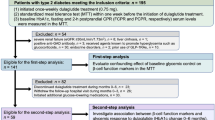Abstract
We investigated the clinical factors that affected routine laboratory tests of C-peptide levels (CPR) used for the evaluation of β-cell function in Japanese patients with type 2 diabetes. The study subjects were 215 Japanese patients with type 2 diabetes admitted to Juntendo University Hospital just for glycemic control. β-cell function was evaluated by ΔCPR (6-min postglucagon increment in CPR), CPR index (100 × fasting CPR divided by fasting glucose), and 24-h urinary CPR excretion (U-CPR). Stepwise multiple regression analyses of relationships between clinical parameters and these laboratory tests were carried out. The analysis identified BMI and treatment with insulin before admission, but not glycosylated hemoglobin at admission, as independent determinants of all β-cell function tests [BMI: Stdβ (standard regression coefficient) = 0.337, P < 0.01 for ΔCPR, Stdβ = 0.365, P < 0.01 for CPR index, and Stdβ = 0.207, P < 0.01 for U-CPR, and treatment with insulin before admission: Stdβ = −0.141, P = 0.023 for ΔCPR, Stdβ = −0.285, P < 0.01 for CPR index, and Stdβ = −0.258, P < 0.01 for U-CPR]. The estimated glomerular filtration rate (eGFR) was an independent determinant of U-CPR (Stdβ = 0.145, P = 0.023), but not ΔCPR. In conclusion, ΔCPR evaluates β-cell function without being affected by eGFR and glycemic control over the preceding 2–3 months.


Similar content being viewed by others
References
DeFronzo RA, Abdul-Ghani M. Type 2 diabetes can be prevented with early pharmacological intervention. Diabetes Care. 2011;34(Suppl 2):S202–9.
U.K. prospective diabetes study 16. Overview of 6 years’ therapy of type II diabetes: a progressive disease. UK Prospective Diabetes Study Group. Diabetes. 1995; 44:1249–58.
Aoki Y. Variation of endogenous insulin secretion in association with treatment status: assessment by serum C-peptide and modified urinary C-peptide. Diabetes Res Clin Pract. 1991;14:165–73.
Goto A, Takaichi M, Kishimoto M, Takahashi Y, Kajio H, Shimbo T, Noda M. Body mass index, fasting plasma glucose levels, and C-peptide levels as predictors of the future insulin use in Japanese type 2 diabetic patients. Endocr J. 2010;57:237–44.
Siraj ES, Reddy SS, Scherbaum WA, Abdulkadir J, Hammel JP, Faiman C. Basal and postglucagon C-peptide levels in Ethiopians with diabetes. Diabetes Care. 2002;25:453–7.
Hendriksen C, Faber OK, Drejer J, Binder C. Prevalence of residual B-cell function in insulin-treated diabetics evaluated by the plasma C-peptide response to intravenous glucagon. Diabetologia. 1977;13:615–9.
Matsuda A, Kamata I, Iwamoto Y, Sakamoto Y, Kuzuya T. A comparison of serum C-peptide response to intravenous glucagon, and urine C-peptide, as indexes of insulin dependence. Diabetes Res Clin Pract. 1985;1:161–7.
Koskinen PJ, Viikari JS, Irjala KM. Glucagon-stimulated and postprandial plasma C-peptide values as measures of insulin secretory capacity. Diabetes Care. 1988;11:318–22.
Gjessing HJ, Matzen LE, Faber OK, Frøland A. Fasting plasma C-peptide, glucagon stimulated plasma C-peptide, and urinary C-peptide in relation to clinical type of diabetes. Diabetologia. 1989;32:305–11.
Funakoshi S, Fujimoto S, Hamasaki A, Fujiwara H, Fujita Y, Ikeda K, Hamamoto Y, Hosokawa M, Seino Y, Inagaki N. Analysis of factors influencing pancreatic beta-cell function in Japanese patients with type 2 diabetes: association with body mass index and duration of diabetic exposure. Diabetes Res Clin Pract. 2008;82:353–8.
Zavaroni I, Deferrari G, Lugari R, Bonora E, Garibotto G, Dall’Aglio E, Robaudo C, Gnudi A. Renal metabolism of C-peptide in man. J Clin Endocrinol Metab. 1987;65:494–8.
ten Dam MA, Werter CJ, Popp-Snijders C, Donker AJ, ten Kate RW. Renal handling of insulin and C-peptide in patients with non-insulin-dependent diabetes mellitus. Nephrol Dial Transpl. 1993;8:134–9.
Matsuo S, Imai E, Horio M, Yasuda Y, Tomita K, Nitta K, Yamagata K, Tomino Y, Yokoyama H, Hishida A. Revised equations for estimated GFR from serum creatinine in Japan. Am J Kidney Dis. 2009;53:982–92.
The Committee on the standardization of diabetes mellitus-related laboratory testing of the Japan Diabetes Society. International clinical harmonization of glycated hemoglobin in Japan: From Japan Diabetes Society to National Glycohemoglobin Standardization Program values. Diabetol Int. 2012;3:8–10.
Taniguchi A, Fukushima M, Sakai M, Kataoka K, Nagata I, Doi K, Arakawa H, Nagasaka S, Tokuyama K, Nakai Y. The role of the body mass index and triglyceride levels in identifying insulin-sensitive and insulin-resistant variants in Japanese non-insulin-dependent diabetic patients. Metabolism. 2000;49:1001–5.
Butler AE, Janson J, Bonner-Weir S, Ritzel R, Rizza RA, Butler PC. Beta-cell deficit and increased beta-cell apoptosis in humans with type 2 diabetes. Diabetes. 2003;52:102–10.
Yoon KH, Ko SH, Cho JH, Lee JM, Ahn YB, Song KH, Yoo SJ, Kang MI, Cha BY, Lee KW, Son HY, Kang SK, Kim HS, Lee IK, Bonner-Weir S. Selective beta-cell loss and alpha-cell expansion in patients with type 2 diabetes mellitus in Korea. J Clin Endocrinol Metab. 2003;88:2300–8.
Aoki Y, Yanagisawa Y, Oguchi H, Furuta S. Contribution of hyperglycemia and renal damage to urinary C-peptide clearance in non-insulin-dependent diabetic patients. Diabetes Res Clin Pract. 1991;14:85–9.
Iseki K. Chronic kidney disease in Japan. Intern Med. 2008;47:681–9.
Matsuzawa Y. The role of fat topology in the risk of disease. Int J Obes (Lond). 2008;32(Suppl 7):S83–92.
Acknowledgments
We thank all the staff at the Department of Medicine, Metabolism and Endocrinology, Juntendo University Graduate School of Medicine.
Conflict of interest
The authors declare that this study has no financial support or relationships that may pose a conflict of interest.
Author information
Authors and Affiliations
Corresponding author
About this article
Cite this article
Kanazawa, A., Tokoro, M., Ikeda, F. et al. Analysis of clinical factors contributing to the postglucagon increment in C-peptide levels in Japanese patients with type 2 diabetes: comparison with basal C-peptide levels and 24-h urinary C-peptide excretion. Diabetol Int 4, 60–65 (2013). https://doi.org/10.1007/s13340-012-0097-4
Received:
Accepted:
Published:
Issue Date:
DOI: https://doi.org/10.1007/s13340-012-0097-4




